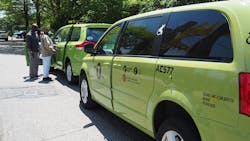Instead of requiring fuel efficiency increases as it did under the Obama administration, the National Highway Traffic Safety Administration (NHTSA) is proposing a new federal approach for light vehicles: skip the expense that such increases require to help hold down costs and get people to buy more new cars.
NHTSA issued a joint notice of proposed rulemaking along with the U.S. Environmental Protection Agency (EPA) that suggests a rollback in NHTSA's Corporate Average Fuel Economy, or CAFE, standards for automakers' fleets of passenger cars, light-duty trucks, and passenger vans up to 10,000 lbs. gross vehicle weight rating. EPA proposes putting the brakes on its targets for carbon dioxide emissions for those vehicles.
More so than it would mean any immediate change, the proposal—which is open for public comments—represents a marked philosophical shift and different approach from the Obama era to the Trump administration.
EPA's and NHTSA's existing fuel economy and emissions program for model year 2017-2025 light vehicles, "consistent with [President Obama's] request, respond[ed] to the country's critical need to address global climate change and to reduce oil consumption."
But there's less need now for the United States to reduce oil consumption, argues a July 9 letter from the U.S. Dept. of Energy (DOE) that NHTSA and EPA included in their proposal package, with the United States now producing far more oil. U.S. crude oil production rose from 6.8 million barrels per day in 2008 to more than 14.2 million barrels a day on average for the first four months of 2018, DOE noted.
Climate change is one thing, but the United States is importing much less oil and is less vulnerable to potential oil supply disruptions. Costs of gasoline and diesel fuel haven't gone up as was expected.
And meanwhile, EPA and NHTSA explain, the value you derive from vehicle fuel efficiency increases goes down as mpg get higher, even as the cost curve of those efficiency gains gets much steeper.
As an example, take a hypothetical pickup truck that could get 10, 15, 25, or 75 mpg that travels 10,000 miles. At 10 mpg it would require 1,000 gallons of fuel to cover that distance; at 15 mpg it would require just under 667 gallons; at 25 mpg it would take 400 gallons; and at 75 mpg it would need about 133 gallons. Going from 10 to 15 mpg you'd save 333 gallons, and from 15 to 25 mpg you'd save 267 gallons.
And once that vehicle hits 25 mpg, to save the same amount of fuel again—267 gallons—you'd need to scale the enormous gap from 25 to 75 mpg. It would likely carry a huge technological and equipment cost to make that leap for comparatively much less fuel savings.
"If gas is cheap and each additional improvement saves less gas anyway, most consumers would rather spend their money on attributes other than fuel economy," the NHTSA/EPA proposal states.
Change in direction
The Obama-era roadmap sought gains in fuel efficiency and reduced carbon dioxide emissions for vehicles with the enticement that this ultimately would save consumers money since they'd spend less on fuel. But the high cost of achieving those goals and low cost of fuel mean that won't pan out, NHTSA and EPA contend.
Their new proposal is to leave fuel efficiency and emissions targets in place through 2020 and then cap them off, holding those levels for model year 2021-2025 light vehicles. That will help keep the cost of vehicles in check, NHTSA and EPA argue, and thereby will help get people to replace older, dirtier, less safe vehicles they've been hanging onto.
"As the average car on the road is approaching 12 years old, apparently the oldest in our history, major safety benefits will occur by reducing fleet age," the agencies' proposal states, speaking of the overall U.S. fleet of light vehicles.
"The industry has achieved tremendous gains in fuel economy over the past decade, and these increases will continue at least through 2020," according to the proposal. "Along with these gains, there have also been tremendous increases in vehicle prices, as new vehicles become increasingly unaffordable."
Though recognizing a cost increase in vehicles, the proposal implies that's due to fuel-saving and emissions-related equipment.
Meanwhile, advanced safety technology like sensors, actuators, cameras, radar, and more powerful computers are mentioned as safety benefits rather than cost items. Multimedia centers and infotainment systems now common in light vehicles appear also as options consumers may prefer to spend money on instead of more fuel-efficient vehicles.
Results
NHTSA's and EPA's light vehicle fuel efficiency and emissions program already in place calls for a real-world fleet-wide average of 52.1-52.9 mpg for passenger cars and 37.6-39.0 mpg for light trucks by 2025 as well as decreasing levels of CO2 emissions. Those targets are progressive by model year.
"A pause in continued increases in fuel economy standards, and cost increases attributable thereto, is appropriate," the proposal argues.
The new proposal would halt the progression in 2020, calling for a fleet-wide average of 43.7 mpg for passenger cars and 31.3 mpg for light trucks. Those targets as well as CO2 emissions levels in 2020 would remain in place through model year 2025.
By the early 2030s, the reduced fuel efficiency and CO2 emissions goals would result in the United States consuming an additional 500,000 barrels of petroleum per day, NHTSA and EPA estimate. "This additional petroleum consumption is, from an economic perspective, dwarfed by the cost savings also projected to result," the agencies state in the proposal, pointing to savings from getting newer vehicles on the road through safety advances and other benefits.
Global atmospheric concentration of carbon dioxide would increase by about two-thirds—0.65—of one particle per million by the year 2100, from 789.11 to 789.76 ppm, according to the proposal's estimates. Earth's temperature would rise by about 0.0054 degrees Fahrenheit.
'One national standard'
The agencies also propose to preempt state efforts, and specifically California's, to impose more stringent fuel economy and emissions standards than the federal ones.
"Eliminating California's regulation of fuel economy . . . will provide benefits to the American public. The automotive industry will, appropriately, deal with fuel economy standards on a national basis—eliminating duplicative regulatory requirements," NHTSA and EPA contend.
"Further, elimination of California's [Zero-Emission Vehicle] program will allow automakers to develop such vehicles in response to consumer demand instead of regulatory mandate," they continue. "This regulatory mandate has required automakers to spend tens of billions of dollars to develop products that a significant majority of consumers have not adopted, and consequently to sell such products at a loss."
NHTSA and EPA argue that California's additional emissions requirements end up costing consumers more money. "All of this is paid for through cross subsidization by increasing prices of other vehicles not just in California and other states that have adopted California's ZEV mandate, but throughout the country," the proposal states.
There is a notable air of federalism: "In short, the agencies propose to maintain one national standard—a standard that is set exclusively by the federal government," NHTSA and EPA emphasize.
Fiat Chrysler Automobiles, while withholding outright support for the joint proposal's preferred option, noted that the proposal recognizes shifts in consumer demand from smaller, fuel-efficient vehicles to larger SUVs, crossovers, pickups, and vans.
"At its core, the proposed rule recognizes that assumptions made in 2012 about consumer preferences have fundamentally shifted in 2018," FCA said in a statement. "The proposal includes a range of options, and we will carefully evaluate how each aligns with FCA's goals of continuous improvement in vehicle efficiency and, at the same time, building vehicles customers want, at prices they can afford."
A final copy will appear in the Federal Register, but the EPA-NHTSA proposal is available now at https://www.epa.gov/sites/production/files/2018-08/documents/safe-my-2021-2026-cafe-ld-ghg-nhtsa-epa-nprm-2018-08-02.pdf.
About the Author
Aaron Marsh
Aaron Marsh is a former senior editor of FleetOwner, who wrote for the publication from 2015 to 2019.

